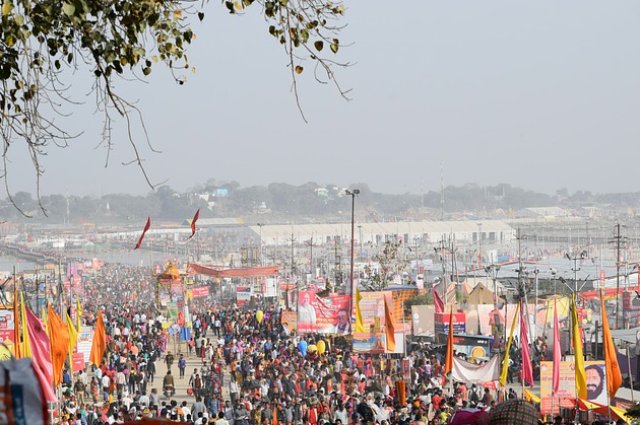
One cold morning in January 2025,
Prakhar sat with his grandmother, Amma, on the terrace of their home in Varanasi.
The sunlight glistened on the Ganges River in the distance, and the air carried the warmth of their steaming cups of chai.
“Amma,” Prakhar said, “I keep hearing about the Kumbh Mela happening in Prayagraj this year. Everyone says it’s extraordinary, but I don’t understand why. What’s so important about it?”
Amma smiled gently, her wise eyes glowing with affection.
“Ah, Prakhar, the Kumbh Mela is not just a gathering. It is a sacred journey, one of the holiest events in Hinduism. Let me tell you its story.”
The Story Behind Kumbh Mela
Amma adjusted her shawl to shield herself from the cool breeze and began,
“The Kumbh Mela comes from a story in our ancient scriptures about the Samudra Manthan—the churning of the ocean. Do you know that story?”
Prakhar nodded.
“Yes, Amma! The gods and demons churned the ocean to find Amrit, the nectar of immortality.”
“Exactly,” Amma said.
“When the Amrit was found, a fight broke out between the gods and demons to claim it. During this struggle, drops of the nectar spilled at four places: Prayagraj, Haridwar, Nashik, and Ujjain. These places became sacred, and that’s why the Kumbh Mela is celebrated there.”
Prakhar leaned forward, curiosity written all over his face.
“Why is Prayagraj the most important of all these places?”
Amma’s voice softened with reverence.
“Prayagraj is where three holy rivers meet—the Ganga, Yamuna, and the mystical Saraswati. This confluence, called the Triveni Sangam, is believed to be the most powerful place to cleanse your soul and wash away sins. Bathing here during the Kumbh Mela is said to bring spiritual freedom and moksha, which is liberation from the cycle of birth and death.”
Why Kumbh Mela Happens at Certain Times
“But Amma,” Prakhar asked, “why does Kumbh Mela happen only at certain times? Why not every year?”
Amma smiled knowingly.
“It’s all about the planets and stars, Prakhar. The timing is based on special celestial alignments. This year, the Kumbh Mela starts on Makar Sankranti, when the sun enters Capricorn. These alignments make the waters of the Sangam even more powerful and divine.”
“Do people believe the water becomes magical during this time?”
Prakhar asked, his eyes wide with curiosity.
“Yes, they do,” Amma said.
“The Ganga is seen as a heavenly river, the Yamuna as devotion, and the Saraswati symbolizes wisdom. During the Kumbh Mela, these rivers are filled with divine energy that can cleanse not just your body but your soul.”
What Happens at Kumbh Mela
“What do people do at the Kumbh Mela?”
Prakhar asked, his voice filled with wonder.
Amma’s voice became lively as she described the scene.
“The most important ritual is the Shahi Snan, the royal bath. Saints and holy men from different monastic groups, called Akharas, lead grand processions to the river. They take the first dip, and people follow them, believing it is the purest way to bathe.”
Prakhar was fascinated.
“And the millions of other people? How do they participate?”
“They come to Prayagraj to bathe in the Sangam and purify their souls,” Amma said.
“But there’s more than just bathing. There are gatherings called satsangs, where saints and gurus share their wisdom. People sing devotional songs, perform rituals, and listen to spiritual teachings. It’s a place where everyone feels closer to God.”
Why People Find It Life-Changing
“Amma,” Prakhar asked, “does going to the Kumbh Mela change someone’s life?”
Amma nodded, her voice filled with conviction.
“Yes, it does, Prakhar. Bathing in the holy waters helps people feel like they’ve left their past mistakes behind. Listening to spiritual teachings gives them new purpose and clarity. Being surrounded by millions of people who share the same faith creates a special energy that stays with you forever.”
Prakhar thought for a moment.
“So, it’s not just about rituals. It’s about finding peace and purpose.”
“That’s right,” Amma said with a smile.
“Kumbh Mela teaches us to live with humility, devotion, and a deep connection to the divine.”
Prakhar’s Decision
As the sun rose higher, Prakhar looked out at the Ganges.
“Amma,” he said with excitement, “will you take me to Prayagraj for the Kumbh Mela? I want to see everything you’ve described—the rituals, the wisdom, the faith.”
Amma’s face lit up with pride.
“Of course, Prakhar. It will be a journey you’ll never forget. But remember, the most important thing is to go with an open heart and a willingness to learn.”
A Sacred Journey Begins
In the weeks that followed, Prakhar prepared for the pilgrimage.
He meditated, read holy scriptures, and talked to spiritual teachers about what to expect.
Finally, the day arrived. Prakhar and Amma joined the crowd of pilgrims heading to Prayagraj.
When they reached the Sangam, Prakhar was amazed to see millions of people gathered, chanting prayers and singing hymns.
As Prakhar took his first dip in the sacred waters, he felt something change within him.
It was as if the weight of his worries lifted, and a deep sense of peace filled his heart.
He understood that life wasn’t just about daily struggles—it was about finding a deeper connection with the divine and living with purpose.
The Kumbh Mela became more than a pilgrimage for Prakhar.
It marked the beginning of his spiritual journey, which would guide him for the rest of his life.
